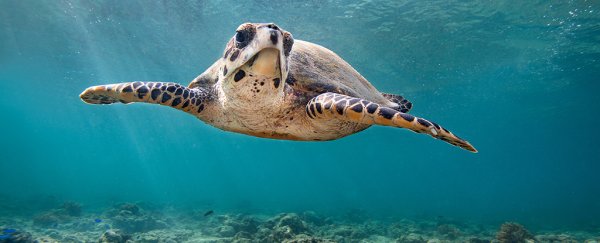How sea turtles and other aquatic life find their way across the open ocean, far from any real navigation aids or natural signposts, has long intrigued biologists. Now, a new study reveals that turtles have basic geomagnetic steering built in – but they're still mostly relying on luck and perseverance to find a destination.
Scientists fitted 22 hawksbill turtles (Eretmochelys imbricata) with GPS trackers to see the routes they would take back to their original foraging grounds after mating and breeding. Those trackers revealed that the routes taken were rather circuitous.
One turtle traveled a total of 1,306 kilometers (812 miles) to find an island just 176 kilometers (109 miles) away from its starting point, for example. The researchers found that in general, there was a lot of swimming around in circles before the animals were able to settle on dry land again.
"Our results provide compelling evidence that hawksbill turtles only have a relatively crude map sense in the open ocean," write the researchers in their published paper.
"The existence of widespread foraging and breeding areas on isolated oceanic sites points to target searching in the final stages of migration being common in sea turtles."
Sea turtles are well known for being able to migrate huge distances across the ocean, often landing upon small and isolated islands a long way from anywhere else – so the question is how they're finding these remote spots surrounded by open water.
While previous research has established that these turtles do have some sense of Earth's magnetic field, which can help in their route planning, up until now it hasn't been clear just how precise or accurate this magnetic mapping technique is.
Typically, the tagged turtles swam twice as far as they needed to do to find foraging sites. Compared to other turtle species though, these hawksbill turtles have relatively short migratory distances to cover.
Changes in the strength and the direction of the magnetic field around Earth are used by multiple species in order to figure out which way to go. In the case of these turtles, that navigation aid appears to work, but only to a certain extent.
"It doesn't allow pinpoint straight-line migration, but it does tell them when they're getting a long way off route," marine ecologist Graeme Hays, from Deakin University in Australia, told The Guardian.
There was some evidence of course correction in both open water and more shallow water closer to land, the researchers report. Many of the findings in this study match up with what's previously been observed in green turtles (Chelonia mydas).
As far as the researchers could tell, ocean currents did not affect the way the turtles got from A to B. Nor did the turtles appear to wait for a certain set of local weather conditions before setting off on their journeys – they began their travels right after breeding.
The behavior and navigation of the turtles is in stark contrast to some sea birds, which usually find their destinations quickly, and most probably use smells carried on the wind to do so. It would appear that sea turtles have no such signals to make decisions from.
"Our findings suggest that sea turtle navigational abilities are far from perfect, but rather may simply be as good as possible within the constraints of their sensory ability," write the researchers.
The research has been published in the Journal of the Royal Society Interface.
